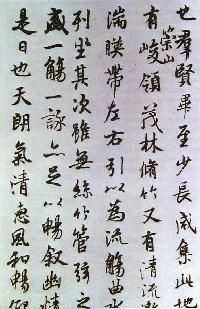|

|
| Preface to the Orchid Pavilion Collection by Wang Xizhi [reproduced by Chu Suiliang] |
Xingshu(running hand or semi-cursive script) was something betweenLishu(the regular script) andCaoshu(the cursive scripts) in the initial period and now is betweenKaishu(the standard script) andCaoshu. No matter which type, when carefully written with distinguishable strokes, theXingshucharacters will be very close to the regular style; when swiftly executed, they will approach theCaoshu. Chinese masters have always compared with vivid aptness the three styles of writing --Kaishu, XingshuandCaoshu-- to people standing, walking and running.
Xingshuis a writing style looser than regular style. This style was created by Liu Desheng in the reigns of Emperors Huan and Ling of the Han Dynasty (206BC-220AD). At the very beginning, it was calledXingya, and later on became an independent form.
Xingshuis considered more abstract and artistic. WritingXingshucharacters is done more quickly thanKaishubut executed with no less care.Xingshuis not as messy asCaoshu, nor as neat asKaishu. In general, it is convenient and highly practical for writing.
Masterpieces ofXingshuincludePreface to the Orchid Pavilion Collectionby Wang Xizhi, which was reputed as No.1XingshuWork. Unfortunately, the original was not handed down, and the one we see today is only a copy of the original work. Due to the high level of the copier, the copy retains the beautiful, neat style.
FamousXingshucalligraphers included Cai Xiang, Su Dongpo, Huang Tingjian and Mi Fu in the Song Dynasty (960-1279), who were called Four Masters of the Song Dynasty. In the Ming (1368-1644)) and Qing (1644-1911) dynasties and modern times, many calligraphers good atXingshucame into being.
